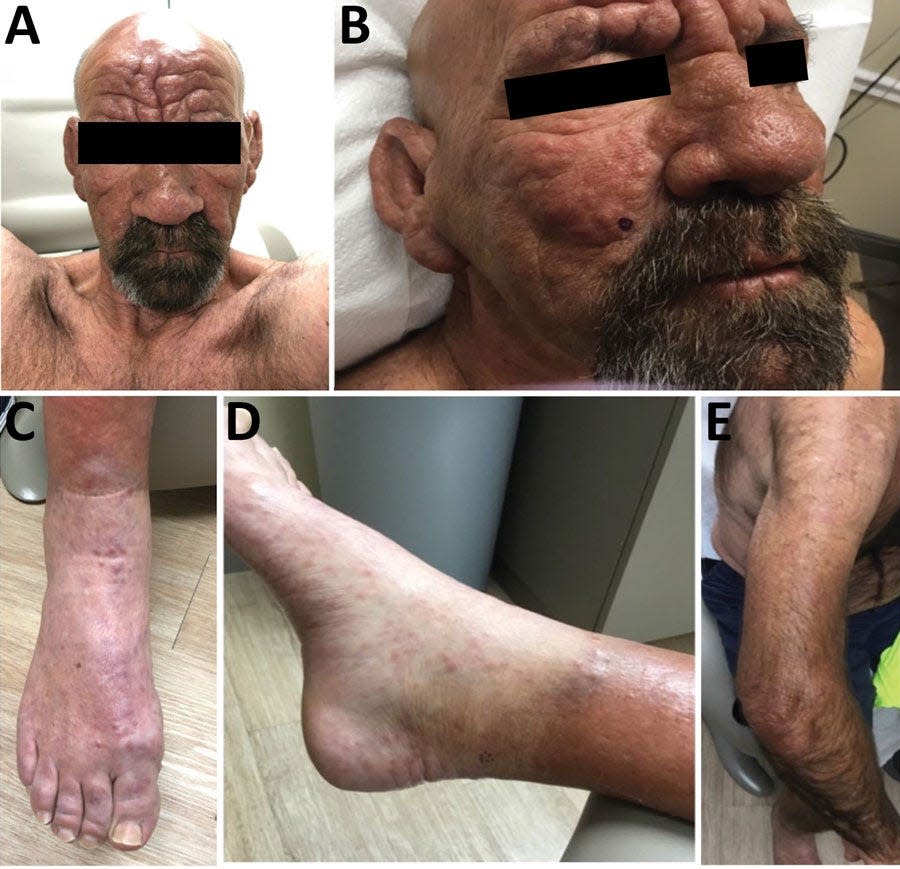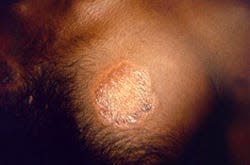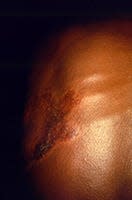Evidence reveals leprosy endemic in parts of US but can you really get it from armadillos?
Leprosy, considered by many a frightening disease from biblical times, still exists today, especially in Central Florida which accounts for 81% of cases reported in the state and almost one fifth of reported cases across the U.S.
The increase of the number of leprosy cases "contribute to rising evidence that leprosy has become endemic in the southeastern United States. Travel to Florida should be considered when conducting leprosy contact tracing in any state," the Centers for Disease Control reported in August.
Each year, about 150 people in the United States and 250,000 around the world get leprosy, known as Hansen's disease.
In the past, Hansen’s disease was feared as a highly contagious, devastating disease. It's now known it is hard to spread and is easily treatable once recognized, according to the Centers for Disease Control.
Leprosy in Florida: Leprosy cases in central Florida account for nearly 20% of national cases. What to know
What is an epidemic? Leprosy, malaria, COVID: What is an endemic? What you need to know
What is Hansen's disease, also known as leprosy?
Hansen’s disease — also known as leprosy — is an infection caused by a bacteria called Mycobacterium leprae. These bacteria grow very slowly, and it may take up to 20 years to develop signs of the infection.
The disease can affect the nerves, skin, eyes, and lining of the nose. If the bacteria attack the nerves, the affected areas can lose the ability to sense touch and pain, which can lead to injuries.
How do people get Hansen’s disease?
About 95% of people are not susceptible to infection, according to the Health Resources and Services Administration
It is not known exactly how Hansen’s disease spreads between people but some scientists think it may happen when a person with Hansen’s disease coughs or sneezes, and a healthy person breathes in the droplets containing the bacteria.
However, prolonged, close contact with someone with untreated leprosy over many months is needed to catch the disease.
You cannot get leprosy from a casual contact with a person who has Hansen’s disease. For example shaking hands or hugging or sitting next to each other.
Hansen’s disease is not passed on from a mother to her unborn baby during pregnancy and it is not spread through sexual contact.
Due to the slow-growing nature of the bacteria and the long time it takes to develop signs of the disease, it is often very difficult to find the source of infection.
Can you get leprosy from armadillos?
It's possible, but unlikely.
A genetic study at the National Hansen’s Disease Program reported armadillos may be a source of infection.
In the southern United States, some armadillos are naturally infected with the bacteria that causes leprosy. It may be possible that they can spread it to people, according to the Centers for Disease Control.
"However, the risk is very low and most people who come into contact with armadillos are unlikely to get Hansen’s disease."
It should be assumed that an infected armadillo could be a source of infection to a susceptible person in contact with its bodily fluids or organs, according to the Florida Department of Health.
Leprosy or Hansen’s disease has not been identified in any other wildlife to date.
What should you do if you're around an armadillo?
The CDC advises people to avoid contact with armadillos whenever possible.
But if you've had contact with an armadillo and are worried about getting Hansen’s disease, talk to your doctor.
Your doctor will follow up with you over time and perform periodic skin examinations to see if you develop the disease.
In the unlikely event that you have Hansen’s disease, your doctor can help you get treatment.
Can a dog or cat be infected with leprosy?
No, dogs, cats and most animals other than armadillos are not susceptible to infection with Hansen’s disease, according to the Florida Department of Health..
Where in Florida has leprosy been reported?

Hansen’s disease has been reported in Florida since 1921, according to the Florida Department of Health.
Up until 1975, an average of four cases were reported each year, with 80% of the 226 cases occurring in people living in Monroe, Dade and Hillsborough counties.
Another 82 cases were reported between 1976 and 1995.
An analysis of 24 confirmed or probable cases reported between 1987 and 1995 found more than half (57%) of the cases resided in southeast Atlantic Coast counties, with others from counties along the south-central Gulf Coast or mainland.
How do you know if you have leprosy?
Hansen’s disease can be recognized by patches of skin that may look lighter or darker than the normal skin. Sometimes the affected skin may be reddish. Loss of feeling in these skin patches is common. You may not feel a light touch or a prick with a needle.
To confirm the diagnosis, your doctor will take a biopsy of your skin or nerve to look for the bacteria under the microscope.
Is there a treatment for Hansen's disease?
Early diagnosis and treatment usually prevent disabilities that can result from the disease, and people with Hansen’s disease can work and lead an active life. Once treatment is started, the person is no longer contagious. However, it is very important to finish the entire course of treatment.
An estimated 6,500 patients are currently being treated in the U.S., according to the Florida Department of Health. Approximately 200 to 250 new cases are reported annually and 80% to 90% of these are immigrants, mostly from Mexico.
Hansen’s disease is treated with a combination of antibiotics. Typically, two or three antibiotics are used at the same time. This strategy helps prevent the development of antibiotic resistance by the bacteria, which may otherwise occur due to length of the treatment.
Treatment usually lasts between one to two years. The illness can be cured if treatment is completed as prescribed.
What if you don't get treated for leprosy?
If left untreated, nerve damage can result in paralysis and crippling of hands and feet.
In very advanced cases, the person may have multiple injuries due to lack of sensation, and eventually the body may reabsorb the affected digits over time, resulting in the apparent loss of toes and fingers.
Corneal ulcers or blindness can also occur if facial nerves are affected. Other signs of advanced leprosy may include loss of eyebrows and saddle-nose deformity.
Antibiotics used during the treatment will kill the bacteria that cause leprosy. But while the treatment can cure the disease and prevent it from getting worse, it does not reverse nerve damage or physical disfiguration that may have occurred before the diagnosis.
It is very important the disease be diagnosed as early as possible, before any permanent nerve damage occurs.
Signs and symptoms of leprosy
Symptoms for Hansen's disease mainly affect the skin, nerves, and mucous membranes.
It can take two to 10 years for signs and symptoms to develop following exposure, and it usually takes weeks to months for the disease to progress once the first signs of infection appear, according to the Florida Department of Health.
Skin symptoms include:

Discolored patches of skin, usually flat, that may be numb and look faded (lighter than the skin around).
Growths (nodules) on the skin.
Thick, stiff or dry skin.
Painless ulcers on the soles of feet.
Painless swelling or lumps on the face or earlobes.
Loss of eyebrows or eyelashes.
Symptoms caused by damage to the nerves include:

Since Hansen’s disease affects the nerves, loss of feeling or sensation can occur. When loss of sensation occurs, injuries such as burns may go unnoticed. Because you may not feel the pain that can warn you of harm to your body, take extra caution to ensure the affected parts of your body are not injured.
Numbness of affected areas of the skin.
Muscle weakness or paralysis (especially in the hands and feet).
Enlarged nerves (especially those around the elbow and knee and in the sides of the neck).
Eye problems that may lead to blindness (when facial nerves are affected).
Symptoms caused by the disease in the mucous membranes include:
A stuffy nose.
Nosebleeds.
If left untreated, the signs of advanced leprosy can include:
Paralysis and crippling of hands and feet.
Shortening of toes and fingers due to reabsorption.
Chronic non-healing ulcers on the bottoms of the feet.
Blindness.
Loss of eyebrows.
Nose disfigurement.
Other complications that may sometimes occur include:
Painful or tender nerves.
Redness and pain around the affected area.
Burning sensation in the skin.
Is Hansen's disease contagious?
Yes, the infection can be acquired from untreated infected people. However, it is not spread through casual contact such as shaking hands or sitting next to someone during a trip or at a meal.
The exact way Hansen’s disease is spread has not been determined because it is so uncommon. Some suspect some individuals develop high levels of the M. leprae bacteria in their noses and spread the bacteria to others who are not immune and who are in prolonged contact with the infected individual.
Infected people who are treated quickly become non-infectious to others.
Who is most at risk for leprosy?
In the U.S., Hansen’s disease is rare. Around the world, as many as 2 million people are permanently disabled as a result of Hansen’s disease.
Overall, the risk of getting leprosy for any adult around the world is very low. That’s because more than 95% of all people have natural immunity to the disease.
You may be at risk for the disease if you live in a country where the disease is widespread. Countries that reported more than 1,000 new cases of Hansen’s disease to the World Health Organization between 2011 and 2015 are:
Africa: Democratic Republic of Congo, Ethiopia, Madagascar, Mozambique, Nigeria, United Republic of Tanzania.
Asia: Bangladesh, India, Indonesia, Myanmar, Nepal, Philippines, Sri Lanka.
Americas: Brazil.
What does the National Hansen’s Disease Program do?
Located in Baton Rouge, the National Hansen's Disease Program:
Cares for patients at its facility in Baton Rouge.
Oversees an ambulatory care network with clinics throughout the United States and Puerto Rico and makes referrals for treatment.
Consults with private sector physicians and accepts referrals for patients with Hansen's disease (leprosy)-related complications.
Advances treatment and educates medical professionals about Hansen's disease (leprosy).
Conducts research intramural Hansen's disease (leprosy) biomedical research.
Reaches out to medical professionals with a comprehensive Hansen's disease (leprosy) training program.
Things to know about Hansen's disease, leprosy
According to the National Hansen’s Disease Program:
Most (95%) of the human population is not susceptible to infection with M. leprae, the bacteria that causes Hansen's disease (leprosy).
Treatment with standard antibiotic drugs is very effective.
Patients become noninfectious after taking only a few doses of medication and need not be isolated from family and friends.
Diagnosis in the U.S. is often delayed because health care providers are unaware of Hansen's disease (leprosy) and its symptoms.
Early diagnosis and treatment prevents nerve involvement, the hallmark of Hansen's disease (leprosy), and the disability it causes.
Without nerve involvement, Hansen's disease (leprosy) would be a minor skin disease.
159 new cases were reported in the U.S. in 2020 (the most recent year for which data are available).
Most (110 or 69%) of these new cases were reported in:
Florida
California
Louisiana
Hawaii
New York
Texas
This article originally appeared on Treasure Coast Newspapers: Florida leprosy: Armadillos carry bacteria causing Hansen's disease

